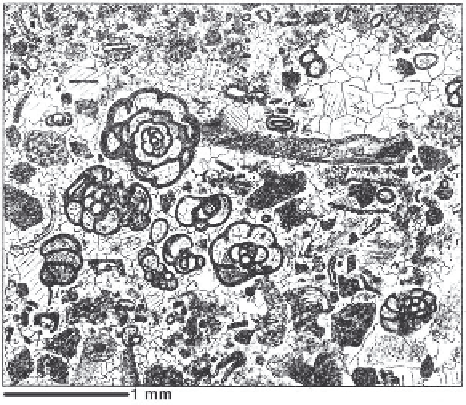Geology Reference
In-Depth Information
to have had symbionts (Ross 1972; Hallock 1985).
Many larger foraminifera have chambers which are sub-
divided into smaller chamberlets. Most fusulinids sub-
divided the chambers by septal fluting (folding of sep-
tal walls) similar to Tertiary alveolinids.
Other larger foraminifera have small bar-like ele-
ments starting at the septa and forming additional sub-
divisions within the shell. These exoskeletal structures
are known from the Late Permian verbeekinid fus-
ulinids, but are also very common in Jurassic, Cret-
aceous and Tertiary agglutinated foraminifera (e.g. Pl.
69/2). Endoskeletal structures are arranged from one
septum to the other and reflect the direction of the proto-
plasma flow. Some Late Cretaceous and Cenozoic larger
foraminifera (Rotaliina) have a channel system and a
lamellar-perforated wall consisting of inner and other
lamellae.
Fig. 10.25.
Smaller foraminifera
are used for the biozona-
tion and correlation of carbonates deposited on Carbonifer-
ous shelves and ramps. The biozones can be correlated both
on a regional and a global scale. The sketch exhibits a grain-
stone with different sections of
Endothyranopsis
and other
foraminifera, indicating an Early Viséan age. After Sorby
(1879).
Distribution and fossil record of foraminifera
Examples of foraminifera common in thin sections
of Late Paleozoic, Jurassic, Cretaceous and Tertiary
limestones are shown on Pl. 67 to Pl. 75. For Triassic
foraminifera see Pl. 111. Box 10.4 lists relevant papers.
Benthic foraminifera have been known since the
Early Cambrian. During the Carboniferous and Permian
an explosive radiation took place, specially among
larger foraminifera (Fusulinacea). Carbonate rocks with
abundant benthic foraminifera have been common since
the Early Carboniferous and became widely distributed
in the Cretaceous and Tertiary. Planktonic foraminifera
evolved in the Middle Jurassic and became major con-
stituents of the marine plankton during the Cretaceous.
minifera taken from different phylogenetic lines (Conil
and Lys 1964; Mamet 1977; Conil et al. 1981; Lys 1988;
Fig. 10.25). These zones were recognized in limestones
formed in shallow subtidal parts of platform and ramp
environments. Smaller foraminiferal assemblages also
assist in the zonation of Late Permian shelf carbonates
(Okimura et al. 1985; Noé 1988).
Smaller foraminifera often comprise only less than
5% of the rock volume, but may increase to more than
20% in grainstones. Common shallow-marine facies
types of bedded Viséan platform carbonates yielding
benthic smaller foraminifera are (a) grain-, pack- and
wackestones with crinoids, bryozoans, brachiopods,
dasyclad green algae and ungdarellacean red algae (Pl.
56/7), (b) fine-grained peloidal grainstones, and (c) la-
goonal wackestones and packstones. Foraminifera are
rare to absent in oolitic limestones (but see Fig. 4.22),
deeper-water crinoid limestones and basinal sediments.
In graded calciturbidites intercalated within basinal
sediments, smaller foraminifera are differentiated by
size, indicating hydraulic sorting of microbiota derived
from all the parts of adjacent platforms (Herbig and
Mamet 1994).
Statistically-based association patterns of Early Car-
boniferous and Permian foraminifera are indicative of
specific shelf habitats (Gallagher 1998). Distribution
of taxa, frequency patterns and association types of
Paleozoic smaller foraminifera permit various parts of
platforms, ramps and mud mounds to be differentiated
Early Paleozoic:
An overview of Paleozoic fora-
minifera was given by Ross and Ross (1991). Cam-
brian foraminifers are poorly documented (e.g. Cherchi
and Schroeder 1984). Evolution was slow during the
Ordovician. Silurian populations were rather small and
diversity very low. Nearly all Cambrian to Silurian fora-
minifera are characterized by agglutinated single-cham-
bered tests. The first major radiation took place in the
Middle Devonian and culminated in the Late Frasnian.
Devonian microgranular and agglutinated foraminifera
occur in shallow-marine and basinal facies types. Fusu-
linid Parathuramminacea were common in back-reef
and lagoonal carbonates (Fig. 10.24). The Devonian
fauna became almost extinct in the Famennian and was
replaced by the endothyrid group. This group had a
major outburst in the Tournaisian and the Viséan.
Late Paleozoic:
Nineteen Tournaisian, Viséan and
lower Middle Carboniferous biozones have been es-
tablished based on assemblages of benthic smaller fora-
Text continued on p. 464

